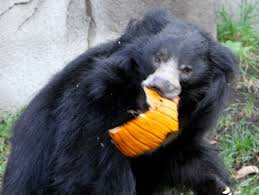Ordinary Bears
Sloth Bear
The sloth bear (Melursus ursinus), also known as the labiated bear, is a nocturnal insectivorous bear species native to the Indian subcontinent. The sloth bear evolved from ancestral brown bears during the Pleistocene and shares features found in insect-eating mammals through convergent evolution. The population isolated in Sri Lanka is considered a subspecies. Unlike brown and black bears, sloth bears have lankier builds, long, shaggy coats that form a mane around the face, long, sickle-shaped claws, and a specially adapted lower lip and palate used for sucking insects.
Although largely considered to be an extension of the brown bears and hence insect-eating mammals, the Sloth bear is also known for its sweet tooth, like the other bears, as well as a large variety of vegetables and fruit.

These bears are known to at times have the tendency to fight for food. Food is a strategic cause of behavioural attitude in sloth bears. According to Wikipedia, sloth bear attacks accounted for the deaths of 48 people and the injuring of 686 others between 1989 and 1994, probably due in part to the density of population and competition for food sources. According to Wikipedia, Sloth bears are distinguished from Asian black bears by their lankier builds, longer, shaggier coats, pale muzzles, and white claws.
The following is a video of sloth bears playing :
Key Takeaways
Type your key takeaways here.
- First: Don’t mess with the Sloth bear, even though it’s only a brown bear and really sloth.
- Second: Sloth bears are nocturnal
- Third: Sloth bears from the South Asia
Key Takeaways
Sloth bears likely view humans as potential predators, as their reactions to them (roaring, followed by retreat or charging) are similar to those evoked in the presence of tigers and leopards.

